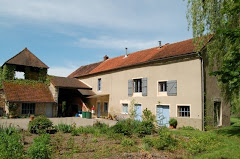 When we came here, in 2005, there was a huge building bordering the Voie Verte, on which was written in mega letter size “MUSEE DU VELO”. It would be quite difficult to come up with a better location for a museum dedicated to the bicycle. The owner, a man from Tournus, rented the building and had on display a collection of over 200 old and new(er) bicycles, bicycle tax shields from the Netherlands and Belgium, posters for the Tour de France, trophies, jerseys in various colours, in short anything remotely connected to bicycles and bicycle racing. We have been there a number of times, and not just for the collection (after the 3rd visit one knows what there is on display). It was also a place where one could, after a long cycle ride on a hot day, sit down and have a drink or an ice cream. Unfortunately, in 2007 the museum closed down. According to those in the know it closed because of the declining number of visitors, and because the commune of Cormatin did not provide sufficient support (read subsidies). The next year the building reopened, this time carrying the name of Musée du Poilu. Poilu (=hairy) was the name for the French soldiers fighting during the Great War. The museum displays artefacts and utensils made by the soldiers in the trenches in between charges. As materials they used everything that was abundant in the trenches: shrapnel, cartouches, even aluminium from the ignition mechanism of grenades, brass, cartridge cases, shells. The collection is interesting enough, but, although the Great War has asked its toll in this part of France just as in any other part, the real fighting took place much further North from here, this location seems to me (literally) a bit out of place. Having said that, the museum is still open, and features in the summertime theatre plays about the home front during the Great War. There certainly seems to be a market for this museum.
When we came here, in 2005, there was a huge building bordering the Voie Verte, on which was written in mega letter size “MUSEE DU VELO”. It would be quite difficult to come up with a better location for a museum dedicated to the bicycle. The owner, a man from Tournus, rented the building and had on display a collection of over 200 old and new(er) bicycles, bicycle tax shields from the Netherlands and Belgium, posters for the Tour de France, trophies, jerseys in various colours, in short anything remotely connected to bicycles and bicycle racing. We have been there a number of times, and not just for the collection (after the 3rd visit one knows what there is on display). It was also a place where one could, after a long cycle ride on a hot day, sit down and have a drink or an ice cream. Unfortunately, in 2007 the museum closed down. According to those in the know it closed because of the declining number of visitors, and because the commune of Cormatin did not provide sufficient support (read subsidies). The next year the building reopened, this time carrying the name of Musée du Poilu. Poilu (=hairy) was the name for the French soldiers fighting during the Great War. The museum displays artefacts and utensils made by the soldiers in the trenches in between charges. As materials they used everything that was abundant in the trenches: shrapnel, cartouches, even aluminium from the ignition mechanism of grenades, brass, cartridge cases, shells. The collection is interesting enough, but, although the Great War has asked its toll in this part of France just as in any other part, the real fighting took place much further North from here, this location seems to me (literally) a bit out of place. Having said that, the museum is still open, and features in the summertime theatre plays about the home front during the Great War. There certainly seems to be a market for this museum. In our local variety of the Cormatin Times we saw recently articles emerging about a resurfacing of the Musée du Vélo (in the words of their PR manager “Unique en France”), not in Cormatin however, but in Tournus. And indeed, the museum will reopen on June 19, and the Commune of Tournus has offered the space for this museum, for a trial period of 3 months. The tragedy of it all is, that the owner of the collection, Michel Grézaud, did not live to see the day. He died beginning of this month, just before his dream would have come true again.....
In our local variety of the Cormatin Times we saw recently articles emerging about a resurfacing of the Musée du Vélo (in the words of their PR manager “Unique en France”), not in Cormatin however, but in Tournus. And indeed, the museum will reopen on June 19, and the Commune of Tournus has offered the space for this museum, for a trial period of 3 months. The tragedy of it all is, that the owner of the collection, Michel Grézaud, did not live to see the day. He died beginning of this month, just before his dream would have come true again.....For our own website click here.





